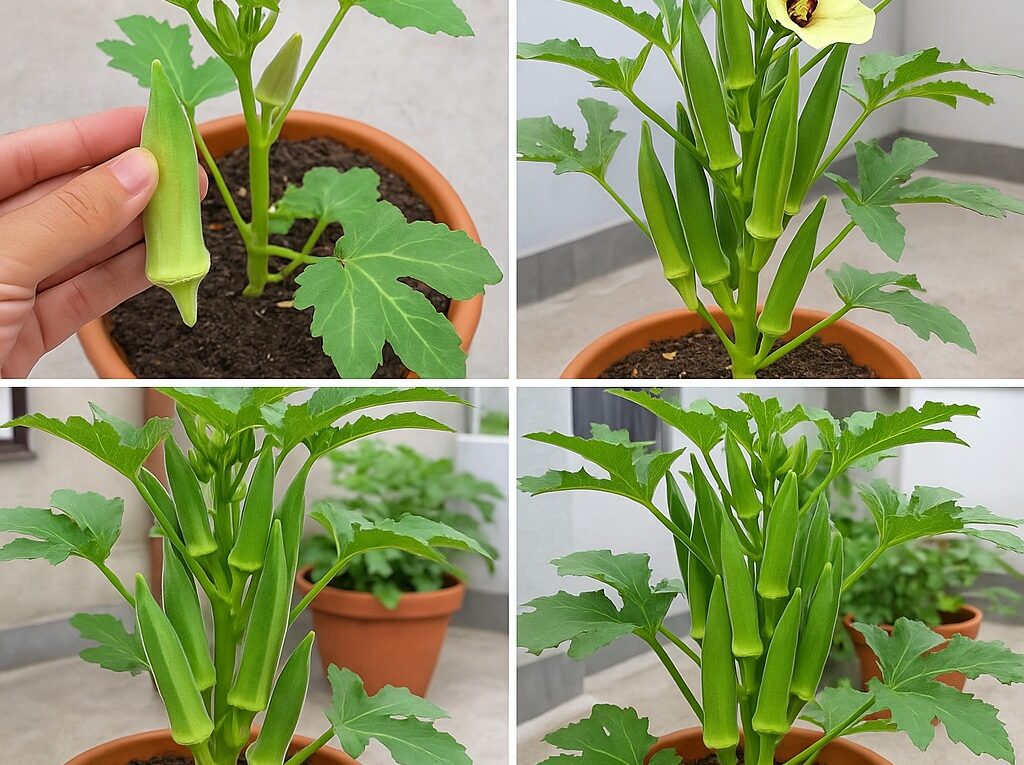The method of growing okra on the terrace with many fruits
How to Grow Okra on a Terrace for Maximum Yield
Growing vegetables on your terrace is an excellent way to enjoy fresh produce while making the most of limited space. Among the easiest and most productive crops for urban gardening is okra (also known as lady’s finger). With the right setup and care, you can grow a thriving okra plant on your terrace and enjoy a continuous harvest of tender pods throughout the growing season.
Here’s a detailed method to grow okra successfully on your terrace with high fruit production:
1. Choosing the Right Variety
Start by selecting a high-yielding and pest-resistant variety of okra. There are several hybrid and local varieties available in garden centers or online. Some popular options include Clemson Spineless, Emerald, and local heirloom varieties. Make sure the seeds are fresh and suitable for container gardening.
2. Container Selection
Okra plants develop a long taproot, so they need deep containers. Choose a pot or grow bag that is at least 12 to 18 inches deep and wide enough to give each plant room to grow. A 14-inch diameter pot is ideal for one plant. If you are using grow bags, pick one with a minimum capacity of 15–20 liters.
Ensure the container has proper drainage holes to prevent water stagnation.
3. Soil Preparation
Okra thrives in well-drained, loamy soil rich in organic matter. Prepare a soil mix using:
-
40% garden soil
-
30% compost (vermicompost or cow dung compost)
-
20% coco peat (for moisture retention)
-
10% sand (for drainage)
Mix thoroughly before filling the pot. You can also add a handful of neem cake or bone meal to boost nutrients and keep soil-borne pests away.
4. Sowing Seeds
Soak okra seeds in water for 6–12 hours before sowing. This helps soften the seed coat and speeds up germination. Sow the seeds directly in the container about 1 inch deep, placing two seeds per pot. After germination, thin to retain the healthiest seedling.
The best time to plant okra is during spring and summer when temperatures remain consistently above 20°C (68°F).
5. Sunlight Requirements
Okra is a sun-loving plant. Place the containers where they receive at least 6 to 8 hours of direct sunlight daily. Adequate sunlight ensures strong growth and high fruit yield.
6. Watering
Water the plant regularly but moderately. Keep the soil moist but not waterlogged. Overwatering can lead to root rot, while underwatering can stress the plant and reduce yield. Early morning or evening is the best time to water terrace plants.
7. Fertilization
To encourage flowering and fruiting, apply a balanced liquid fertilizer (such as compost tea or fish emulsion) every 10–15 days. Once the plant starts flowering, supplement with potassium-rich fertilizers like banana peel fertilizer or wood ash to support pod development.
Avoid nitrogen-heavy fertilizers after the plant matures, as they can promote leafy growth at the expense of flowers and fruits.
8. Pruning and Maintenance
Keep the plant healthy by removing yellowing or damaged leaves regularly. You can also pinch the top of the main stem when the plant reaches about 2 feet tall to encourage branching and more pod production.
Mulching with dry leaves or straw helps retain soil moisture and suppress weeds.
9. Pest and Disease Management
Common pests affecting okra include aphids, mealybugs, and whiteflies. Inspect your plants regularly. You can control these pests naturally using neem oil spray (mix 5 ml neem oil with 1 liter of water and a few drops of liquid soap). Spray every 7–10 days in the early morning or late evening.
To prevent fungal diseases, avoid overhead watering and ensure good air circulation between plants.
10. Harvesting
Okra pods grow quickly. Begin harvesting when the pods are 3 to 4 inches long and still tender. Mature pods become fibrous and tough, so pick every 2–3 days to encourage new pod development.
Always use clean scissors or a knife to avoid damaging the plant.
Final Tips for High Yields
-
Continue feeding with compost every month.
-
Stake the plant if it grows tall and seems unstable.
-
Rotate crops if you’re planting in the same containers season after season.
With the right care, your terrace okra plant can keep producing pods for two to three months, offering a rewarding harvest from even the smallest urban garden.
